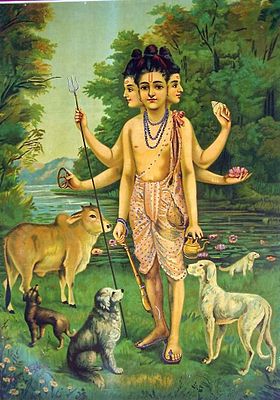Datta Jayanti
This article needs additional citations for verification. (April 2015) |
| Datta Jayanti | |
|---|---|
 Dattatreya, the incarnation of the trimurtis, Brahma, Vishnu and Shiva | |
| Also called | Dattatreya Jayanti |
| Observed by | Prayers and religious rituals, including puja to Dattatreya |
| Type | Hindu |
| Significance | Fasting, meditation and prayers day |
Datta Jayanti, also known as Dattatreya Jayanti, is a Hindu festival, commemorating the birth day celebration of the Hindu Deity Dattatreya (Datta), a combined form of the Hindu male divine trinity of Brahma, Vishnu and Shiva.
It is celebrated on the full moon day of the Margashirsha (Agrahayana) month according to the Hindu Calendar (December/January) throughout the country, and in particular in Maharashtra.[2][3]
Legend[edit | edit source]
Dattatreya was the son of the sage Atri and his wife Anasuya. Anasuya, an archetypal chaste and virtuous wife, did severe Tapas (austerities) to beget a son equal in merits as Brahma, Vishnu and Shiva, the Hindu male trinity (Trimurti). Saraswati, Lakshmi and Parvati, the goddess trinity (Tridevi) and consorts of the male trinity, became jealous. They deputed their husbands to test her virtuousness.
The three gods appeared before Anasuya in the disguise of sanyasis (ascetics) and asked her to give them alms naked. Anasuya was perplexed for a while, but soon regained composure. She uttered a mantra and sprinkled water on the three mendicants, turning them into babies. She then breast fed them with her milk naked, as they wished. When Atri returned to his ashram (hermitage), Anasuya narrated the event, which he already knew through his psychic powers. He hugged the three babies to his heart, transforming them into a single baby with three heads and six arms.
As the triad of gods did not return, their wives got worried and rushed to Anasuya. The goddesses begged her forgiveness and requested her to return their husbands. Anasuya accepted their request. The Trimurti then appeared in their true form, before Atri and Anasuya, and blessed them with a son Dattatreya.
Though Dattatreya is considered a form of all the three deities, he is especially considered an avatar of Vishnu, while his siblings the moon-god Chandra and the sage Durvasa are regarded forms of Brahma and Shiva respectively.[3][4]
Worship[edit | edit source]
On Datta Jayanti, people take bath early in the morning in holy rivers or streams, and observe fast. A puja of Dattatreya is performed with flowers, incense, lamps, and camphor. Devotees meditate on his image and pray to Dattatreya with a vow to follow in his footsteps. They remember Dattatreya's work and read the sacred books Avadhuta Gita and Jivanmukta Gita, which contain the god's discourse.[3] Other sacred texts like the Datta Prabodh (1860) by Kavadi Baba and the Datta Mahatmya by Param Pujya Vasudevananda Saraswati (Tembe Swami Maharaj), both of which are based on Dattatreya's life, as well as the Guru-charita based on the life of Narasimha Saraswati (1378−1458), considered an avatar of Dattatreya, are read by devotees.[5] Bhajans (devotional songs) are also sung on this day.
Datta Jayanti is celebrated with much fanfare in the god's temples. The temples dedicated to Dattatreya are located throughout India, the most important places of his worship are in Karnataka, Maharashtra, Andhra Pradesh and Gujarat like Ganagapur in Karnataka near Gulbarga, Narasimha Wadi in the Kolhapur district, Pithapuram in Andhra Pradesh near Kakinada, Audumbar in Sangli district, Ruibhar in Osmanabad district and Girnar in Saurashtra.[6]
Some temples like Manik Prabhu Temple, Manik Nagar host an annual 7-day festival in honour of the deity in this period. In this temple, Datta Jayanti is celebrated for 5 days from Ekadasi to Poornima. People from Maharashtra, Karnataka, and Telangana come here to have darshan of the deity.[citation needed] The saint Manik Prabhu, who is also regarded as an incarnation of Dattatreya by the people of Datta Sampraday, was born on Datta Jayanti.[5]
Datta Jayanti was celebrated by Sadguru Shree Aniruddha Upasana Trust (Mumbai, India) in Amalner city in Jalgaon district of Maharashtra, India between 30 November to 3 December 2017 wherein thousands of devotees from various parts of Maharashtra participated and took blessings of Lord Dattatreya. Shri Ganpati Atharvashirsha, Lalita Ambika Poojan, Datta Bawani, and Shri Datta Sahastranaam were chanted in this four-day event. With the spirit of self-discipline, the foundation managed the event in peace and harmony.[7]
References[edit | edit source]
- ↑ "2012 Dattatreya Jayanti". Dripanchang. Retrieved 11 December 2012.
- ↑ Dr. Bhojraj Dwivedi (2006). Religious Basis Of Hindu Beliefs. Diamond Pocket Books (P) Ltd. pp. 125–. ISBN 978-81-288-1239-2. Retrieved 10 December 2012.
- ↑ 3.0 3.1 3.2 Sunil Sehgal (1999). Encyclopaedia of Hinduism: C-G. Sarup & Sons. pp. 501–. ISBN 978-81-7625-064-1. Retrieved 10 December 2012.
- ↑ Datta Jayanti
- ↑ 5.0 5.1 Eleanor Zelliot; Maxine Berntsen (1988). The Experience of Hinduism: Essays on Religion in Maharashtra. SUNY Press. p. 374. ISBN 978-0-88706-664-1. Retrieved 15 December 2012.
- ↑ Sir Swami Samarth. Sterling Publishers Pvt. Ltd. 21 February 2008. pp. 203–. ISBN 978-81-207-3445-6. Retrieved 10 December 2012.
- ↑ http://epaperdivyamarathi.bhaskar.com/chalisgaon/265/05122017/0/3/

